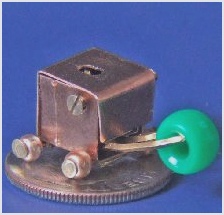
I can remember growing up you would sometimes see a comedy bit on TV that showed a grandpa with a primitive hearing device to help him with his terrible hearing. In the bit, the senior citizen used a huge cone that was about three times as big as his head which he would stick in his ear to amplify the sound. And if I remember right, it never worked very well.
I don't know if that method of supplementing hearing was every popular but we have had conventional hearing aids around for a long time. In a way to a casual observer, the hearing aid seems to do the opposite of what it is supposed to do. That is because if you see someone wearing a hearing aid, the device blocks the opening to the ear. So it would seem that keeps the person from hearing well when the opposite is actually the truth.
A very basic hearing aid is actually a pretty simple device. You can think of it as a PA system in reverse. Instead of taking sound and amplifying it over a large space to many, it amplifies it into a very small space to just one person. But the base components of the hearing aid are a microphone, a battery and a small amplifying circuit that makes the sound louder and easier to understand and then transmits that sound back into the patient's inner ear where it can be clearly understood.

This very basic design served for a long time under the analog method of sound transmission. But the design has been adapted to a number of different ways that simple design if used for different kind of patients and to deal with different kinds of hearing loss. For example, in an early design, the entire device except for the amplification transmitter existed in a small box worn on the back of the ear. This kept the mechanism clean and out of the ear of the patient and allowed the box to be large enough for ease of access to change the battery.
Over time, this basic design has been expanded, adapted and enhanced. Analog hearing aids are still around but now hearing aid patrons can also look into getting a digital hearing device which translates the sounds it picks up into a digital signal and then into the ear. The value here is that digitization has allowed hearing aids to get very small so many hearing aids can reside easily just inside the ear where they are not so conspicuous. In fact, in some cases, very small hearing aids can be implanted into the ear in such a way that nobody even knows it is there.
Controls have been added to both analog and digital hearing aids so the wearer has the ability to adjust the quality of sound coming in as well as to filter out surface noise and deal with different frequencies differently depending on what the hearing need is. All of these have made hearing aids better and more adaptable to may people's needs. And we can only expect that medical technology will continue to enhance hearing aid technology even more in the future.
No comments:
Post a Comment